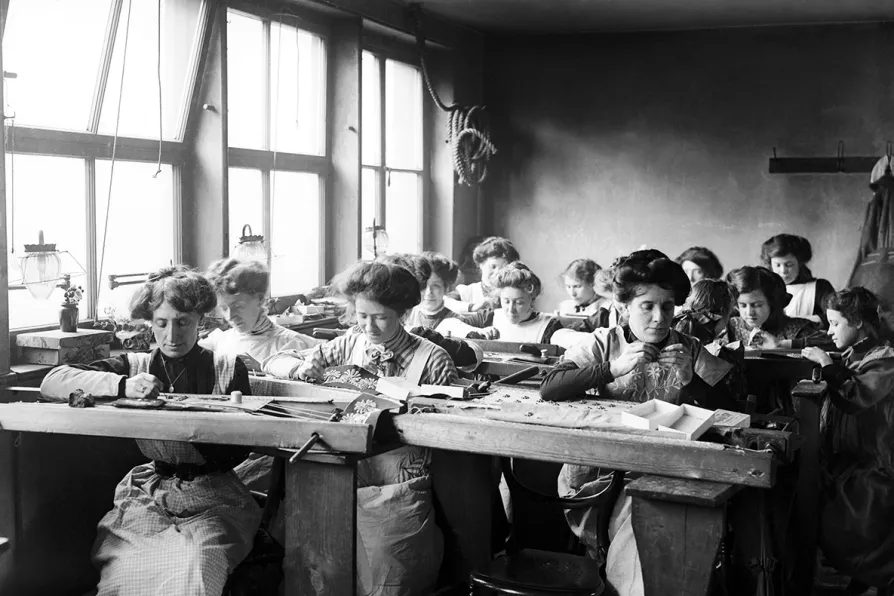CAMERON HARRISON and CJ ATKINS analyse the White House’s new strategy in detail
ANN HENDERSON looks at the trailblazers of the Women’s Trade Union League and their successful fight for female factory inspectors — a battle that echoes in today’s workplace campaigns

 Women workers in 1910
Women workers in 1910
AS THE STUC Women’s Conference meets in Glasgow later this week, it provides another welcome opportunity to remember some of the challenges faced by women trade union activists from the past, and the need to build on hard-won improvements to women’s working conditions.
The TUC was established in 1868, bringing trade unionists together from across Britain. It wasn’t until 1897 that the Scottish TUC was established as a distinct structure, and the first STUC women’s advisory committee meeting was held in 1926.
1875, 150 years ago, was the first time that women delegates were in attendance at the TUC congress. At that TUC congress in 1875, held in Glasgow as it happens, Edith Simcox (1844-1901) and Emma Paterson (1848-1886) represented the Women’s Trade Union League, which had been initially named the Women’s Protective and Provident League when established by Emma Paterson in 1874. Thousands of working-class women had already been organised and helped by Emma Paterson through these early days of trade union activity.
The working conditions for women in the textile mills and in factories were horrendous, and often not addressed by the growing network of male trade unions. Accounts from various parliamentary commissions and reports identify that women workers wanted to be able to talk to women representatives.
At that time, Emma believed and demonstrated that the effective organising of the women across a whole range of textile and clothing manufacturing jobs gave women a voice. That voice was taken to the TUC that year in Glasgow, and in the years to follow.
In 1878, three years later, the TUC was meeting in Bristol. Emma Paterson, on behalf of the WTUL, proposed a simple amendment to a resolution that was on the agenda.
The congress was considering how to engage with the implementation of the Factory and Workshops Act 1878, which sought to consolidate numerous sector-specific and smaller pieces of legislation.
Factory inspectors had a crucial role to play in enforcement. The TUC resolution urged the appointment of “practical working men” as inspectors. Emma’s amendment was to include “and women” in this resolution, and was carried by congress.
Emma Paterson and the WTUL then led on organising a conference to advocate for the appointment of women factory inspectors, and year on year, the TUC congress reaffirmed its support for this policy, yet found various reasons not to give it priority in its discussions with Parliament.
Women’s working conditions continued to deteriorate, dominated by low wages, long hours, and insanitary working conditions. Other sections of society took this up too, with the Women’s Liberal Federation, for example, taking on the argument for women inspectors from 1890 onwards.
From 1881 onwards, “practical working men” were included in the male appointees to the factory inspectorate, but it was not until 1893 that the first two women factory inspectors were appointed, paid less than their male counterparts, but with the specific remit to engage with women workers.
One was May Tennant, and the other, Mary Paterson. Mary was from Glasgow and had studied and spoken up about women’s working conditions.
These two women, to be joined by a number of other female inspectors over the next few years, worked extremely hard to visit factories and sweatshops across the country, inviting the women workers to speak with them, taking complaints up with management, and taking evidence gathered to royal commissions and to Parliament.
By 1921, with 30 women inspectors, the female inspectorate was merged into the factories inspectorate.
Adelaide Anderson, retiring then as “His Majesty’s Principal Lady Inspector of Factories,” wrote a fascinating account of the work of these women inspectors, published in 1922, Women in the Factory, now out of print.
She writes of the risks to which women were exposed, long hours without breaks, insanitary and unventilated working spaces, harmful chemicals, unsafe machinery, “sweated” labour, low wages or payment in goods not money, and malnutrition.
She refers to testimony from the Women’s Trade Union League, from the Legal Advice Bureau for Working Women, and from Mary McArthur at the National Federation of Women Workers, all confirming that the visible presence of “the woman inspector” was giving women workers some confidence, a sense that someone was interested in their conditions, and to feel better protected.
Ventilation and lighting, both so important in a workplace, only came into the parliamentary legislative sphere as pressure mounted from the factory inspectorate reports. And the female inspectorate developed a whole body of work about the experience and risks for pregnant women in the workplace.
Legislation which prevented the employment of women until four weeks after childbirth had come onto the statute books in 1891, and was being largely disregarded.
The risks to pregnant women from various chemicals and substances were studied — an example is given of extraordinarily high levels of miscarriage and stillbirth among married women working in the potteries in Staffordshire, and the study undertaken to compare with a similar group of women outside that industry. The women inspectors were also able to take cases to court and to seek compensation for injuries.
Completely inadequate sanitation facilities, toilets and washrooms feature often in the reports, and it is clear that women workers felt more able to raise personal hygiene and privacy concerns directly with women inspectors and with the emerging women’s trade union movement.
This is the work on which our movement today is built — and those gains made owe so much to women like Emma Paterson, who sadly died aged only 38, before the female factory inspectorate came into being, and to those early women factory inspectors.
As the STUC Women’s conference of 2025 brings women trade unionists together again, we confront issues such as workplace support for women during menopause or with endometriosis, investing in childcare, tackling misogyny and sexual harassment, providing suitable PPE, and providing appropriate facilities for breastfeeding mothers, and still tackling unequal pay.
We really should be in a strong position to place the demands and needs of women workers right at the centre of the trade union movement’s bargaining and political agenda. There is still much work to do.
This article is based on a talk given at a well-attended FiLiA trade union session at the FiLiA conference in Brighton recently. More information about the FiLiA Trade Union Women’s Network can be found here: www.filia.org.uk/filia-trade-union-womens-network.
Ann Henderson is the former STUC assistant secretary and part of the FiLiA Trade Union Women’s Network.

Women are a vital part of the labour movement and have much to contribute, but there’s far more to be done to make sure that our sisters’ voices are truly heard, says PHILIPA HARVEY

ANN HENDERSON on the exciting programme planned for this summer’s festival in the Scottish capital

ROS SITWELL reports from the Morning Star conference on ‘Race, Sex and Class Liberation’ last weekend











